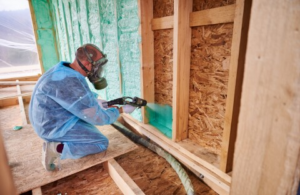Hvac Lexington is an industry that requires extensive training and education. It also involves working non-traditional hours and responding to emergency repair calls.
Air filters need to be changed regularly to prevent clogging. Evaporator and condenser coils should also be cleaned to prevent ice from forming and improve energy efficiency.

Air conditioning is the part of your heating, ventilation, and air conditioning system (HVAC) that cools. The system chills refrigerant (with an outside unit) and blows it through ductwork to cool your home.
To get the most out of your air conditioner, keep it well-maintained by regularly sweeping away dust and debris. It’s also a good idea to brush out the coils and drain pan on a regular basis.
In addition to keeping your home cool, the air conditioning system helps to dehumidify indoor spaces. This is important to avoid mold, mildew and other unhealthy growths as well as to make your home more comfortable.
An effective HVAC system requires control over four fundamental variables: air temperature, humidity, movement and quality. The difference between industrial and residential applications is that industrial applications generally require better control of air quality due to hazardous substances such as welding fumes.
To reduce indoor humidity, you can use an exhaust fan during activities that produce moisture, such as cooking, bathing, washing, and drying clothes. Alternatively, you can install a whole-house dehumidifier.
In addition to cooling and dehumidifying, an efficient air conditioning system should have good air filtration. To prevent pollutants from entering your home, you can have a professional test your system for leaks and ductwork cleanliness. If necessary, you can have ducts cleaned, or seal cracks and openings with caulk and weather stripping.
Another way to lower indoor humidity is by lowering outdoor air temperatures. This can be done by using a programmable thermostat to set your heating and cooling systems to turn on at different times of day depending on outdoor temperatures.
An effective air conditioning system should have easy access to all components and controls. This is especially important in schools and commercial buildings where maintenance workers must be able to access equipment without requiring the removal of ceiling tiles or climbing on roof tops. This can be accomplished by designing a system where the air handling units, controls, and exhaust fans are not located in rooms that require the use of a ladder or the removal of ceiling tiles.
Furnace
Furnaces are a crucial part of home air conditioning systems. They work with ductwork to create a comfortable environment in homes. In addition, they function in conjunction with air filters to keep the air clean.
The furnace is a heating source that uses either natural gas, oil, or propane to heat and distribute warm air in the house. Furnaces are usually located in the basement or garage, but they can be found in other places in some homes.
A furnace has a blower that moves the warm air into air ducts, which distribute it throughout the house. The hot air is then cooled and returned to the furnace to be heated again. This cycle repeats until the desired temperature is reached. Furnaces use a heat exchanger to convert fossil fuel energy into thermal energy. They also have a fan that blows air over the exchanger to help with the process.
Some furnaces are powered by natural gas, which is delivered through a line that runs to the house from a nearby utility company. Other furnaces are powered by electricity, which can be very expensive in some areas. Oil furnaces, although a less common option, are still used in some areas of the country.
Furnaces should be regularly inspected and cleaned by professionals. During maintenance, professionals check for residue buildup and other possible issues that may lead to heat loss. They also clean the blower motor, burners, and other key parts to prevent problems. Professionals also replace the air filter and refill the refrigerant when needed.
A well-maintained furnace can save money on heating and cooling costs, as well as improve indoor air quality by lowering dust levels in the house. This is important because dust can cause respiratory problems in some people and increase allergens like pollen.
Regular maintenance can also help extend the life of a furnace and keep it running at peak efficiency. This is especially true for a newer furnace that has high AFUE (annual fuel utilization efficiency) ratings. Having the system serviced twice a year is generally recommended by manufacturers, and homeowners should change their furnace’s air filter at least every three months.
Ductwork
Air ducts connect HVAC units to different living spaces, channeling cooled or heated indoor air throughout. They also return stale indoor air to the HVAC unit for reconditioning. The duct system must be carefully designed to ensure the right airflow, eliminate turbulence and pressure losses, and maintain a comfortable temperature.
A poorly designed duct system can make a home or business less comfortable. It can also lead to a higher energy bill and create unhealthy indoor air. It can also cause dust accumulation and even mold growth.
Ducts should be inspected regularly to avoid problems like these. The duct system should be surveyed by an experienced professional for leaks, cracks, and other defects. The ductwork should also be surveyed for proper size and material.
Proper duct sizing relies on an analysis of required airflow (CFM) based on square footage and usage. A specialized software tool called a ductulator helps HVAC contractors calculate CFM. The ducts should be sized to deliver the correct CFM with acceptable pressure loss.
Rigid sheet metal ducts are the best choice for most homes because of their durability and low surface friction. They’re also easy to clean. Other types of ducts include flexible plastic and fiberglass. Flexible ducts can develop holes and leaks over time. Fiberglass ducts are susceptible to mold, which can contaminate the air and can be toxic if inhaled.
If a duct is damaged, it should be replaced or repaired as soon as possible to prevent air from being lost. A qualified contractor will replace leaking ducts and seal joints with caulk. They’ll also install new insulation to keep the conditioned air inside the ducts.
One of the most common signs of a problem with the ductwork is whistling or rattling noises when the HVAC system turns on. A loose or disconnected duct can cause this, especially if it’s located in an attic. It’s also a good idea to have a professional inspect the ductwork if you notice musty odors or mildew stains around the vents. These are signs of improper filtration, which could be caused by a dirty filter or a clogged duct.
Thermostat
Your thermostat plays a critical role in keeping your home comfortable. It monitors the ambient temperature and instructs your heating and cooling system to make changes once it reaches or falls below a pre-programmed set point. It’s a pretty simple device that contains some pretty cool technology.
A traditional thermostat works based on the fundamental principles of thermal expansion and contraction. Inside the thermostat are two strips of different metals bolted together that form a bridge within an electrical circuit that’s connected to your HVAC system. These strips, which are called bimetallic strips, expand or contract depending on how hot or cold it is outside your home. By doing this, they’re able to switch on and off an electric current that signals your HVAC system to produce cool or warm air.
Smart Wi-Fi thermostats have a similar setup but run on software instead of mechanical parts. Occasionally, this software can experience glitches that hinder performance. In these instances, it’s best to contact the manufacturer or a home heating repair company for troubleshooting advice.
Thermostats that don’t work correctly put unnecessary strain on your HVAC system, which can lead to costly repairs and higher than normal energy bills. One common problem is short-cycling, which occurs when your thermostat frequently switches on and off. This puts extra wear and tear on your equipment and can result in lower air quality.
You can improve your thermostat’s performance by regularly replacing its batteries, checking that the breaker isn’t tripped in your electrical panel and cleaning the sensor to remove dust and dirt. Another easy fix is to make sure that your thermostat is in a good location. It should be away from direct sunlight, other heat sources and cold drafts.
If you’re having an issue with your thermostat, don’t hesitate to contact the experts at Roznovak’s Services today. We’ll get to the bottom of your system malfunction problems, so you can enjoy a more efficient home comfort. We offer reliable heating service and AC repair in St. Louis. Schedule a visit online or give us a call!






